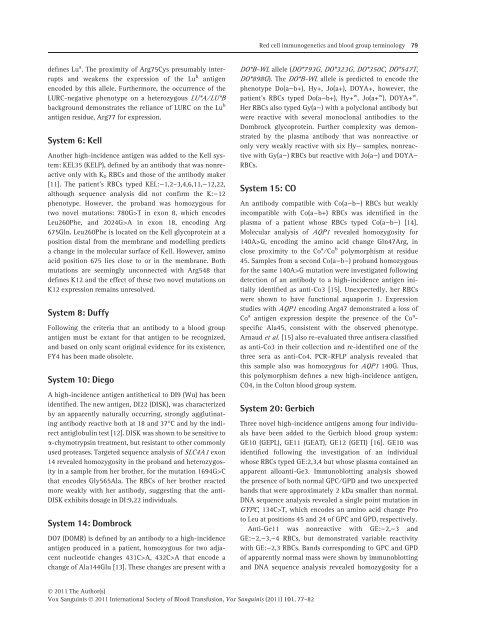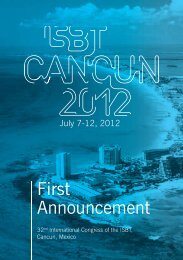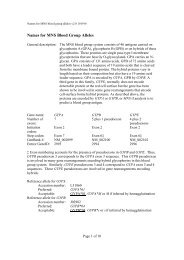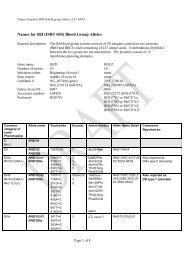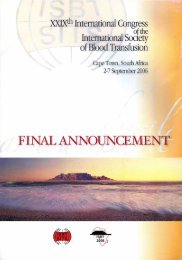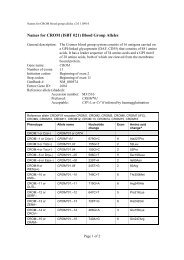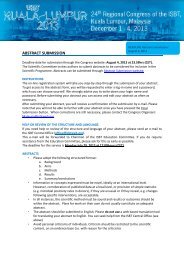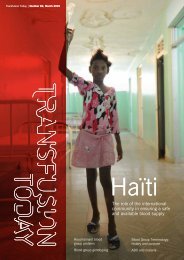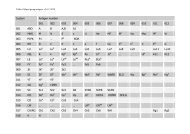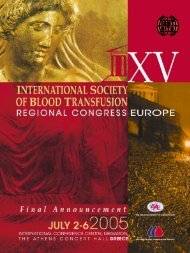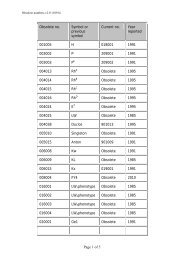International Society of Blood Transfusion Working Party on red cell ...
International Society of Blood Transfusion Working Party on red cell ...
International Society of Blood Transfusion Working Party on red cell ...
- No tags were found...
Create successful ePaper yourself
Turn your PDF publications into a flip-book with our unique Google optimized e-Paper software.
Red <strong>cell</strong> immunogenetics and blood group terminology 79defines Lu a . The proximity <str<strong>on</strong>g>of</str<strong>on</strong>g> Arg75Cys presumably interruptsand weakens the expressi<strong>on</strong> <str<strong>on</strong>g>of</str<strong>on</strong>g> the Lu b antigenencoded by this allele. Furthermore, the occurrence <str<strong>on</strong>g>of</str<strong>on</strong>g> theLURC-negative phenotype <strong>on</strong> a heterozygous LU*A ⁄ LU*Bbackground dem<strong>on</strong>strates the reliance <str<strong>on</strong>g>of</str<strong>on</strong>g> LURC <strong>on</strong> the Lu bantigen residue, Arg77 for expressi<strong>on</strong>.System 6: KellAnother high-incidence antigen was added to the Kell system:KEL35 (KELP), defined by an antibody that was n<strong>on</strong>reactive<strong>on</strong>ly with K 0 RBCs and those <str<strong>on</strong>g>of</str<strong>on</strong>g> the antibody maker[11]. The patient’s RBCs typed KEL:)1,2–3,4,6,11,)12,22,although sequence analysis did not c<strong>on</strong>firm the K:)12phenotype. However, the proband was homozygous fortwo novel mutati<strong>on</strong>s: 780G>T in ex<strong>on</strong> 8, which encodesLeu260Phe, and 2024G>A in ex<strong>on</strong> 18, encoding Arg675Gln. Leu260Phe is located <strong>on</strong> the Kell glycoprotein at apositi<strong>on</strong> distal from the membrane and modelling p<strong>red</strong>ictsa change in the molecular surface <str<strong>on</strong>g>of</str<strong>on</strong>g> Kell. However, aminoacid positi<strong>on</strong> 675 lies close to or in the membrane. Bothmutati<strong>on</strong>s are seemingly unc<strong>on</strong>nected with Arg548 thatdefines K12 and the effect <str<strong>on</strong>g>of</str<strong>on</strong>g> these two novel mutati<strong>on</strong>s <strong>on</strong>K12 expressi<strong>on</strong> remains unresolved.System 8: DuffyFollowing the criteria that an antibody to a blood groupantigen must be extant for that antigen to be recognized,and based <strong>on</strong> <strong>on</strong>ly scant original evidence for its existence,FY4 has been made obsolete.System 10: DiegoA high-incidence antigen antithetical to DI9 (Wu) has beenidentified. The new antigen, DI22 (DISK), was characterizedby an apparently naturally occurring, str<strong>on</strong>gly agglutinatingantibody reactive both at 18 and 37°C and by the indirectantiglobulin test [12]. DISK was shown to be sensitive toa-chymotrypsin treatment, but resistant to other comm<strong>on</strong>lyused proteases. Targeted sequence analysis <str<strong>on</strong>g>of</str<strong>on</strong>g> SLC4A1 ex<strong>on</strong>14 revealed homozygosity in the proband and heterozygosityin a sample from her brother, for the mutati<strong>on</strong> 1694G>Cthat encodes Gly565Ala. The RBCs <str<strong>on</strong>g>of</str<strong>on</strong>g> her brother reactedmore weakly with her antibody, suggesting that the anti-DISK exhibits dosage in DI:9,22 individuals.System 14: DombrockDO7 (DOMR) is defined by an antibody to a high-incidenceantigen produced in a patient, homozygous for two adjacentnucleotide changes 431C>A, 432C>A that encode achange <str<strong>on</strong>g>of</str<strong>on</strong>g> Ala144Glu [13]. These changes are present with aDO*B-WL allele (DO*793G, DO*323G, DO*350C, DO*547T,DO*898G). The DO*B-WL allele is p<strong>red</strong>icted to encode thephenotype Do(a)b+), Hy+, Jo(a+), DOYA+, however, thepatient’s RBCs typed Do(a)b+), Hy+ w , Jo(a+ w ), DOYA+ w .Her RBCs also typed Gy(a)) with a polycl<strong>on</strong>al antibody butwere reactive with several m<strong>on</strong>ocl<strong>on</strong>al antibodies to theDombrock glycoprotein. Further complexity was dem<strong>on</strong>stratedby the plasma antibody that was n<strong>on</strong>reactive or<strong>on</strong>ly very weakly reactive with six Hy) samples, n<strong>on</strong>reactivewith Gy(a)) RBCs but reactive with Jo(a)) and DOYA)RBCs.System 15: COAn antibody compatible with Co(a)b)) RBCs but weaklyincompatible with Co(a)b+) RBCs was identified in theplasma <str<strong>on</strong>g>of</str<strong>on</strong>g> a patient whose RBCs typed Co(a)b)) [14].Molecular analysis <str<strong>on</strong>g>of</str<strong>on</strong>g> AQP1 revealed homozygosity for140A>G, encoding the amino acid change Gln47Arg, inclose proximity to the Co a ⁄ Co b polymorphism at residue45. Samples from a sec<strong>on</strong>d Co(a)b)) proband homozygousfor the same 140A>G mutati<strong>on</strong> were investigated followingdetecti<strong>on</strong> <str<strong>on</strong>g>of</str<strong>on</strong>g> an antibody to a high-incidence antigen initiallyidentified as anti-Co3 [15]. Unexpectedly, her RBCswere shown to have functi<strong>on</strong>al aquaporin 1. Expressi<strong>on</strong>studies with AQP1 encoding Arg47 dem<strong>on</strong>strated a loss <str<strong>on</strong>g>of</str<strong>on</strong>g>Co a antigen expressi<strong>on</strong> despite the presence <str<strong>on</strong>g>of</str<strong>on</strong>g> the Co a -specific Ala45, c<strong>on</strong>sistent with the observed phenotype.Arnaud et al. [15] also re-evaluated three antisera classifiedas anti-Co3 in their collecti<strong>on</strong> and re-identified <strong>on</strong>e <str<strong>on</strong>g>of</str<strong>on</strong>g> thethree sera as anti-Co4. PCR–RFLP analysis revealed thatthis sample also was homozygous for AQP1 140G. Thus,this polymorphism defines a new high-incidence antigen,CO4, in the Colt<strong>on</strong> blood group system.System 20: GerbichThree novel high-incidence antigens am<strong>on</strong>g four individualshave been added to the Gerbich blood group system:GE10 (GEPL), GE11 (GEAT), GE12 (GETI) [16]. GE10 wasidentified following the investigati<strong>on</strong> <str<strong>on</strong>g>of</str<strong>on</strong>g> an individualwhose RBCs typed GE:2,3,4 but whose plasma c<strong>on</strong>tained anapparent alloanti-Ge3. Immunoblotting analysis showedthe presence <str<strong>on</strong>g>of</str<strong>on</strong>g> both normal GPC ⁄ GPD and two unexpectedbands that were approximately 2 kDa smaller than normal.DNA sequence analysis revealed a single point mutati<strong>on</strong> inGYPC, 134C>T, which encodes an amino acid change Proto Leu at positi<strong>on</strong>s 45 and 24 <str<strong>on</strong>g>of</str<strong>on</strong>g> GPC and GPD, respectively.Anti-Ge11 was n<strong>on</strong>reactive with GE:)2,)3 andGE:)2,)3,)4 RBCs, but dem<strong>on</strong>strated variable reactivitywith GE:)2,3 RBCs. Bands corresp<strong>on</strong>ding to GPC and GPD<str<strong>on</strong>g>of</str<strong>on</strong>g> apparently normal mass were shown by immunoblottingand DNA sequence analysis revealed homozygosity for aÓ 2011 The Author(s)Vox Sanguinis Ó 2011 <str<strong>on</strong>g>Internati<strong>on</strong>al</str<strong>on</strong>g> <str<strong>on</strong>g>Society</str<strong>on</strong>g> <str<strong>on</strong>g>of</str<strong>on</strong>g> <str<strong>on</strong>g>Blood</str<strong>on</strong>g> <str<strong>on</strong>g>Transfusi<strong>on</strong></str<strong>on</strong>g>, Vox Sanguinis (2011) 101, 77–82


